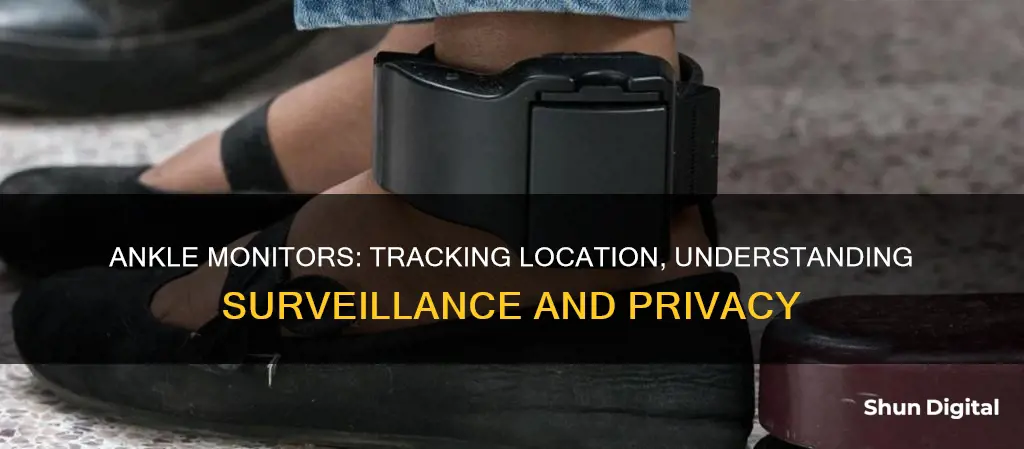
Ankle monitors are often used as an alternative to incarceration, allowing individuals to remain free while awaiting trial or serving probation. These monitors are typically used to track the wearer's location and can be used to ensure they stay within a designated area, maintain a distance from certain people, or adhere to a curfew. The monitors use GPS technology and radio frequency signals to communicate the wearer's location to a monitoring station, and they are designed to be difficult to remove or tamper with. While ankle monitors can provide an opportunity for individuals to avoid jail time, there are also concerns about their effectiveness, impact on rehabilitation, and potential to exacerbate systemic inequities.
| Characteristics | Values |
|---|---|
| Purpose | To ensure the wearer stays within boundaries set by the court |
| Type of tracking | Radio frequency signals, GPS |
| Alert | If the wearer goes outside the designated area, the device vibrates and emits a loud tone |
| Alert | If the wearer doesn't return to the designated area, the device sends an alert to the authorities |
| Installation | A company is usually required to install the monitor |
| Installation cost | Hundreds of dollars |
| Monitoring service cost | Hundreds of dollars per month |
| Alcohol monitoring | The device can also monitor alcohol consumption by testing the wearer's sweat |
| Tampering | All ankle monitor systems have a way to tell if the device has been tampered with |
| Tampering | Tampering with a court-ordered electronic monitoring device is a crime in some states |
| Tracking | Officers can track wearers in real-time |
What You'll Learn

Ankle monitors are used as an alternative to jail sentences
Ankle monitors are used as an alternative to traditional imprisonment, allowing individuals to serve their sentences while remaining in the community. They are typically worn by individuals on probation or parole, those awaiting trial, or those convicted of a crime but considered low-risk and not a danger to the community. The monitors track the wearer's movements and location using GPS technology.
The use of ankle monitors as an alternative to jail sentences offers several advantages. It is less expensive than incarceration and allows individuals to maintain their jobs and support their families, making it easier for them to reintegrate into society upon the completion of their sentences. Additionally, ankle monitors ensure individuals follow court orders and comply with probation or parole requirements.
However, there are also disadvantages and concerns associated with the use of ankle monitors. They can be uncomfortable to wear and cause skin irritation. Individuals with ankle monitors are subject to strict rules and regulations, and any violation can result in additional penalties or imprisonment. The cost of renting and maintaining the device can be a financial burden, especially for those who cannot afford it.
The effectiveness of ankle monitors as a form of punishment and surveillance has been questioned. Some argue that they violate civil rights and impose unfair financial penalties, extending sentences or curtailing freedoms. Additionally, there is limited proof that ankle monitors make communities safer or reduce recidivism.
Ultimately, while ankle monitors can be a viable alternative to jail sentences in certain cases, they should be used with discretion, considering the offender's risk of reoffending and the nature of the crime.
Convincing Mom: Broken Monitor Confessions and Strategies
You may want to see also

They can be used to reduce bail costs
Ankle monitors can be used to reduce bail costs. Here's how:
Lower Bail Amounts
When a court considers an individual a flight risk, a judge may order them to wear an ankle monitor while out on bond. Ankle monitors are usually reserved for people awaiting trial, deemed a danger to the community, or a flight risk. By agreeing to wear an ankle monitor, individuals promise the court that they will not flee or violate any other set conditions, such as sticking to a specific area or adhering to a curfew. This promise can increase the chance of the court granting a lower bail amount or even no bail at all.
Alternative to Pre-Trial Detention
Ankle monitors are often used as an alternative to pre-trial detention or jail sentences. For example, in cases of Driving Under the Influence (DUI) or Driving While Intoxicated (DWI), an individual may avoid jail time by wearing an ankle monitor that can detect alcohol levels, ensuring compliance with court orders not to drink. By agreeing to this alternative, individuals can avoid the high costs of bail and bail bond services, which typically charge a non-refundable fee, usually a percentage of the total bail amount.
Quick Return to Work
Any extra time spent in jail results in a loss of wages. Ankle monitors allow individuals to quickly return to work and make money to pay bail bond fees and GPS monitoring fees. Once an ankle monitor is attached, the monitoring company is informed of the individual's place of employment and work schedule, ensuring that the monitor does not indicate any wrongdoing while at work.
Lower Risk for Bail Bond Companies
Bail bond companies often feel more comfortable with the idea of GPS monitoring as it reduces the risk of bail bond forfeiture. This means that bail bond companies are more likely to approve bail, which can help individuals secure their release from jail faster.
Monitors: What to Know Before You Buy
You may want to see also

They are used for serious crimes, repeat offenders, and domestic violence cases
Ankle monitors are often used as an alternative to incarceration in the criminal justice system. They are typically used to track the wearer's location in real time and are usually attached to the offender's ankle. The device uses GPS or radio frequency to transmit the wearer's location data to a monitoring centre. If the wearer goes beyond a specified area or violates any other conditions set by the court, an alert is sent to the monitoring centre.
Ankle monitors are used in cases of serious crimes, repeat offenders, and domestic violence. In the case of serious crimes such as murder, sexual assault, or major drug offences, courts often require the defendant to wear an ankle monitor as a condition of bail or parole. For repeat offenders, the ankle monitor provides an extra layer of supervision to help prevent them from committing further offences. In domestic violence cases, ankle monitors are used to ensure that the offender maintains a required distance from the victim, giving peace of mind to victims and likely saving lives.
In addition to tracking location, ankle monitors can also detect alcohol levels, which is useful for individuals convicted of multiple DUI or DWI offences to ensure they comply with court orders not to drink. The device can test the wearer's sweat and relay this information to the relevant authorities, including their probation officer. This feature can also be used to monitor individuals on probation for alcohol-related offences.
Ankle monitors are typically used as an alternative to pre-trial detention or as a condition of probation. They can also be used to reduce bail amounts by providing assurance to the court that the defendant will not flee. By agreeing to wear an ankle monitor, individuals may be able to secure a lower bail amount or even avoid bail altogether. However, failure to wear the device could result in higher bail.
The use of ankle monitors varies based on jurisdiction, the severity of the crime, and the individual's criminal history. While they are commonly used for nonviolent crimes, they can also be utilised for serious offences to ensure the safety of victims and the community.
Mounting Your ASUS TUF Monitor: A Step-by-Step Guide
You may want to see also

They can be used for immigration cases
Ankle monitors are sometimes used in immigration cases. As of March 2024, the number of migrants who are electronically monitored, including with GPS, totalled 183,935 families and individuals. This is part of Immigration and Customs Enforcement's (ICE) so-called Alternatives to Detention (ATD) division.
The Intensive Supervision Appearance Program (ISAP) is a program within ATD that uses electronic ankle monitors and phone apps to track people who would otherwise be incarcerated. As of May 2021, 31,069 out of 96,574 individuals enrolled in ISAP were wearing ankle monitors. Those tracked by ISAP are required to be within 70 miles of their home, and they are usually not allowed to cross state lines.
The use of ankle monitors in immigration cases has been defended by the Biden administration as an alternative to detention. However, critics argue that ankle monitors are not a humane alternative to detention, as they can cause physical and psychological harm. A 2021 report by Freedom for Immigrants, the Immigrant Defense Project, and the Benjamin N. Cardozo School of Law found that 12% of surveyed immigrants considered suicide as a result of being monitored, and 88% spoke of mental health issues, trouble sleeping, migraines, and depression. The report also found that 90% of participants experienced harm to their physical health, including cramps, numbness due to impaired circulation, discomfort due to excessive heat from the battery, and swelling.
In addition to the mental and physical health concerns, ankle monitors can also create difficulties in other areas of life. Many immigrants reported trouble sleeping due to the lights, alarm sounds, and vibrations from the monitor's battery, as well as the fear that it wasn't properly charged, which could lead to a call or visit from ICE. Some also reported losing their jobs or having difficulty obtaining work due to the monitor.
Monitoring Employee Internet Usage: Company Strategies and Tactics
You may want to see also

They can be used to monitor alcohol consumption
Ankle monitors are often used to track the location of the wearer. They are usually strapped to the ankle with a tamper-proof band and use GPS to determine the wearer's whereabouts. They are often used as an alternative to jail time or pre-trial detention, and can be used to set a specific area that the wearer must stay within.
In addition to location tracking, ankle monitors can also be used to monitor alcohol consumption. These alcohol-monitoring ankle bracelets are also known as SCRAM bracelets, which stands for "Secure Continuous Remote Alcohol Monitoring". They are often used in cases where the wearer has been convicted of driving under the influence (DUI) or where alcohol use is a problem. The bracelets work by testing the wearer's perspiration for the presence of alcohol every 30 minutes. When a person consumes alcohol, a small amount is excreted through the skin in the form of sweat. The SCRAM bracelet detects the presence of alcohol in this sweat. The data from these tests is then uploaded and monitored by a private company, who will report any positive tests for alcohol to the court.
SCRAM bracelets can be used to ascertain a detailed pattern of alcohol consumption over a specific period, which can then be used in a legal setting. They are able to differentiate between the consumption of alcohol and exposure to external sources of alcohol, such as alcohol-based products. The bracelets also have temperature and infrared sensors that can detect any attempts to tamper with or obstruct the device. This means that if an offender tries to remove the bracelet, the monitoring company will be notified and can report it to the court or probation department.
The use of SCRAM bracelets has been shown to be effective in reducing the risk of reoffending for those convicted of DUI. Courts have decided that the technology is scientifically sound and that evidence of alcohol consumption and tampering is reliable enough to be admitted into court proceedings. The bracelets are usually worn for 30, 60, or 90 days, but in some cases, they may be worn for longer as a term of probation or parole.
Remotely Monitoring Resource Usage: Server Management Techniques
You may want to see also
Frequently asked questions
An ankle monitor is a device worn around the ankle to track the wearer's movement and location. It is usually strapped to the ankle with a tamper-proof band.
Ankle monitors use GPS technology to communicate the wearer's location to a monitoring station. If the wearer goes outside a specific perimeter, the monitor will alert the monitoring station.
Ankle monitors are typically worn by people who are on house arrest, probation, or parole. They may also be worn by defendants awaiting trial, particularly if they are considered a danger to the community or a flight risk.







